The Kensington Food Forest began with a dream, to provide healthy nutritious organic food for our local community, to build resilience around food security. Kensington is an inner city suburb in Melbourne. We wanted to grow our own food to reduce pressure on farmlands, reduce food miles and the subsequent use of fossil fuels in transportation as well as keeping chemicals off our plates and creating community.
After doing my PDC in 2011 and then completing my Permaculture Diploma, I was enthusiastic to make changes. We can’t all run to the country, some of us actually need to clean up our cities..In the last few years I have focused my permaculture efforts to building food security in my neighbourhood and moving it to transition to an energy descent future. I approached Deb Wilson, Community Manager at Unison (then Urban Communities a community housing organisation) in 2015 with an idea to build a food forest on the Kensington Estate. The Kensington estate was a redevelopment that offered integrated public, social and affordable home ownership for low income households. We submitted an application to the City of Melbourne Community Grants for a Food Forest and heard we were successful in late 2015.
In the city, one of the critical challenges we face is lack of space and contaminated soil, most of Melbourne is apparently built on landfill. The councils’ ways of dealing with contaminated soil has been to cover it up or build on top. This creates impervious surfaces and problems with frequent flooding in the city when we have extreme weather downpours (predicted to increase). There is also resistance to growing food in the ground.
I approached Unison as they had some sizeable pieces of land that we could build a food forest/ food garden on. It was important to us that we bought residents from the estate and the wider community along with us to create community ownership for sustainability of care, education about food security and environmental restoration. We developed a Community Engagement and Resident Communication Plan to achieve this.
Our first information session was held in August 2016 and we invited attendees to participate in any of the three stages of building the Food Forest;
- Soil testing/vegetation count;
- The establishment phase and;
- The care and maintenance phase.
About 20 local members undertook soil testing in October 2016. We sent soil samples to Vegesafe at Macquarie University to ensure there was no heavy metal contamination. We did pH tests and field observation such as colour, fertility and drainage.
There was a delay of about a year before the state government department of Human Services and Health (DHHS) approved us establishing a food forest on their land. We had suggested an oddly shaped area of roughly 52m long x 4m wide which was under utilised (i.e. covered with grass). I then designed the food forest and this design was approved in June 2017. We then moved quickly as we wanted the plants to establish themselves in Spring before the hot weather of summer.
The Design
The design converted the current land from grass to a polyculture of 25 productive tree species and supporting guilds (including five Tagasaste for nitrogen fixing and mulch), vines, berries, a medicinal and herbal tea garden ( for colds and flu’s, women’s health and overall wellbeing) , insectories (strategically placed to confuse pests and invite predators) native and bush foods, and an irrigation system. This totals of a further 60 plants.
The species were selected, combined, and delivered to produce all year round as well as provide a diversity of nutrients. These plantings were arranged according to their growing conditions, form, function and outputs. Our maintenance plan was for minimum inputs, so the soil and pest management plan included:
- no bare earth (mulched or covered with ground covers), no tillage, chop and drop (use of green manure and plants for mulch)
- natural pest control using plants to repel pests and attract beneficials.
- maintain healthy soil full of microorganisms
- watering techniques
- drip line for minimum evaporation and drift. Perennials for soil stability and companion planting/guilds. Rotation of annual vegetables for high production and diversity. Use of local, street composting bins for compost and local worm farms for worm juice.
The design created spots to sit and contemplate and watch the changing seasons. Critical to the design was that the forest was publicly accessible and not locked with people encouraged to meander along the paths exploring the variety of species. Signage along the way would educate visitors about the various species and functions of the plants. An easy to operate, manual centralized watering system was important to ensure the forest care team could respond to weather conditions.
Each tree and plant in the forest is doing more than one thing – that is as well as providing food, it is sinking carbon, reducing stormwater runoff, raising the water table, providing shade, lowering heat island affect, cleaning our air, increasing precipitation and providing a home/place for multiple organisms.

Site Summary
The delay allowed the suggested site to be observed over the seasons.
The site is in the temperate climate of Melbourne – it is located inner city and is impacted by the heat island affect from the built surfaces of asphalt roads and concrete buildings so is frost-free and has increased temperatures in summer. Climate change and the summer/winter sun arc were important factors. On the north side of the site there is a high-rise building which creates a big shade arc in the winter afternoon. This high-rise building created wind turbulence as the wind wrapped around the building. Other local conditions created a wind tunnel that buffeted the NE side of the site. We erected a Mediterranean espaliered grove here to counteract this with olive trees.
A number of microclimates were present on the site. Some wet and dry spots were observed alongside human interaction and movements though the site. The soil results came back as below Australian contamination levels. The pH levels ranged across the site, varying from 6 to 8 ½ . Overall the soil was quite different across various sections reflecting different levels of soil life and nutrients, plus compaction. As a result of our soil tests, soil-enhancing work was needed prior to planting out with trees and understory.
Once the design was approved an OHS plan was drawn up for the construction of the food forest. The design was also then presented back to the community and they were invited once again to participate in the two remaining stages: Establishment of the food forest i.e. planting in mulching and: Forest care and maintenance.

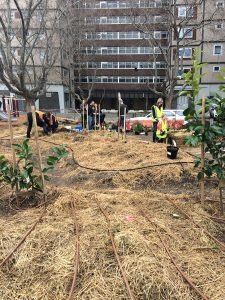
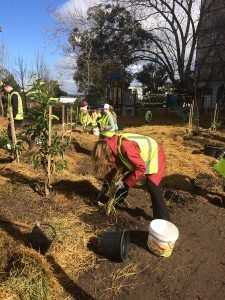
We broke ground on the 4th August using a mini earthmoving machine to remove the grass and shape mounds and break up some of the compacted earth. We removed 10 to 15cm of the top layer of soil – separated grass and gravel, then shaped this into mounds, added compost and lucerne and left for a few weeks to do its magic. Worm juice was also applied. The wooden structures for the espaliered olive windbreak, berry arc and kiwi support were installed.
On two community plant in days in August all trees and supporting understory and guild plants were planted in (some community members donated plants on the design plant list). The crushed rock and sand pathways followed and a forest care team was established early September 2017. They were key in spreading 18m3 of recycled wood mulch with the community across the site.
To activate soil life we planted in a spring green manure.
In the temporary space amongst the plantings of trees and perennial plants, and until the canopy grows, we are planting annual seasonal food. In October we planted over 300 summer seedlings including eggplant, chilli, tomatoes, basil, the three sisters corn, pumpkin and beans.
Our community Food Forest launch day was 28 November 2017. It was a joyous celebration of our diverse community coming together because of something we all had created.

Forest Care team members and community who helped spread 18 m3 of mulch.
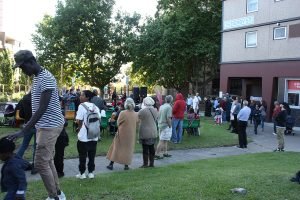
Community Food Forest Launch day
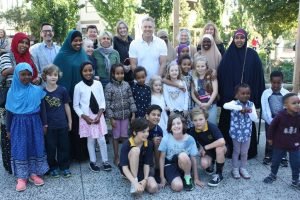
Deputy Lord Mayor of City of Melbourne (centre in white) Cr Arron Wood with some Forest care team members and community who planted in
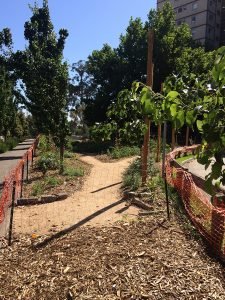
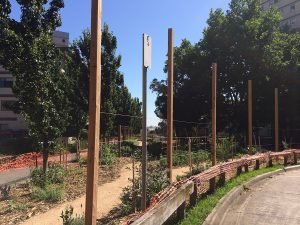
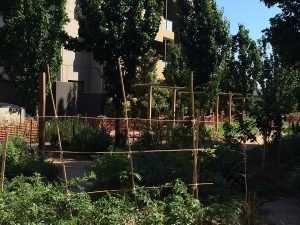
The Food Forest At Launch Day














Excellent work in my old home of Melbourne. Well done to you all!! :-D
Awesome project. Looks fantastic
Wow! Fantastic job!
Love this! So inspired by your project Jacqui Van Heerden… Had heard about you guys however only stumbled on this today… We are doing something similar but much smaller on the back area of a house lot in Albury. It backs onto a lane and we are hoping to get some of the neighbours on each side of the lane involved… It will be a Food is Free Garden to supplement community food needs… i have a big big learning curve in front of me… I hope to learn from your project and have signed up for membership…